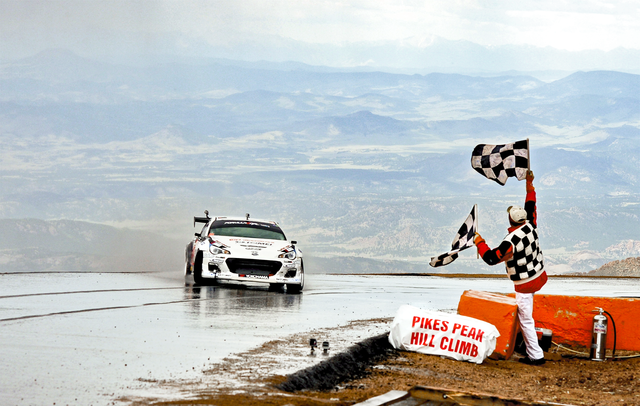The Local newsletter is your free, daily guide to life in Colorado. For locals, by locals.
The Pikes Peak International Hill Climb might not be the oldest motorsports race in America (that’d be the Indianapolis 500; Pikes Peak is second), but it’s probably the most dangerous. Consider the names given to different sections of the 12.5-mile course: Bottomless Pit, Boulder Field, and Devil’s Playground, where Jeremy Foley pinwheeled 500 feet down the mountain in 2012. Co-driver Yuri Kouznetsov—who, along with Foley, miraculously lived—called the crash “a big washing machine of pain and violence.” As the so-called Race to the Clouds celebrates its 100th anniversary this month, competitors’ speeds—and the subsequent risks—are only accelerating.
In 1916, the inaugural Hill Climb invited car enthusiasts to race their Duesenbergs, Hudsons, and Cadillacs to the top of Pikes Peak on the dirt road that Spencer Penrose, founder of the Broadmoor resort, had built a year earlier. The winners finished in around 20 minutes. Today, cars and motorcycles travel the 156-turn, now-paved course in less than half that time. Insane? Maybe. OK, probably. But the route provides an ideal proving ground for drivers and manufacturers. “If you could win on the hill, everyone knew you could win anywhere,” says Al Unser Sr., the 1964 and ’65 Pikes Peak winner who would go on to win four Indianapolis 500s. In 2013, a French driver piloted an 875-horsepower car to the top in eight minutes and 13 seconds (despite having to dodge a spectator who crossed right in front of his car), a record that still stands. That engendered instant street cred for carmaker Peugeot, which built the car especially for Pikes Peak.
Of course, triple-digit speeds, sheer cliffs, and daring temperaments create opportunities for disaster. Six people—including one race official who was hit by a car during practice—have died during the race, four of them since 2000. This year Ducati, a motorcycle manufacturer, will enlist a team of veteran racers to mentor motorcycle riders. Formerly, there were few, if any, barriers between fans and cars along the course. In recent years, however, spectator areas have been elevated—for prime viewing and also for safety. Those spotted wandering outside one of the seven designated areas might earn trespassing tickets or be detained by local authorities. Still, the Race to the Clouds isn’t distancing itself too far from its hazardous past. Just ask Foley. The twisted carcass of the Mitsubishi he wrecked hangs in the race museum in Colorado Springs, a less-than-subtle reminder of the risk drivers assume in pursuit of the summit.
Date: June 26
Tickets: $60–$240 in advance, $70–$320 on race day
Don’t Miss: The entire week is full of events, including Fan Fest on June 24 in downtown Colorado Springs. There will be a beer garden, free swag, and up-close viewing of the race cars and motorcycles.









